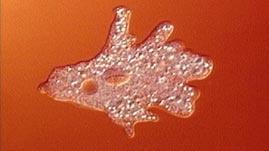Most Single Celled Organisms Reproduce By
For many single-celled organisms asexual reproduction is a similar process. In asexual reproduction one organism produces one or more new organisms that are identical to itself.

Types Of Microorganism Plant And Animal Cells Protists Biology Art
Single-celled organisms reproduce asexually by dividing.

Most single celled organisms reproduce by. The parent cell simply divides to form two daughter cells that are identical to the parent. Sexual reproduction is the production by parents of sex cells and the fusion of two sex cells to form a single unique cell. Can be seen without a microscope.
In this process a single celled organism splits down the middle to create two identical cells. Details of the process differ greatly from one form to the next and if the higher ciliate protozoans are included can be extraordinarily complex. You might say that single-celled organisms.
Asexual reproduction produces offspring that are genetically identical to the parent whereas sexual reproduction produces a similar. In what ways if any does a single celled organism. Some cells do this through the process of binary fission.
For a long time it wasnt recognized that they also have a number of strategies for sharing genetic information some of which are analogous to sex. They are found in almost all habitats from hot springs to frozen tundra. Some single-celled organisms reproduce by a process called In binary fission material from one cell separates into two cells.
A type of cell division called meiosis leads to the cells that are part of the sexual reproductive cycle. The unicellular organisms usually reproduce by asexual means. In this case identical generations are formed because the daughter cells are identical clone cells only.
Reproduction of organisms In single-celled organisms eg bacteria protozoans many algae and some fungi organismic and cell reproduction are synonymous for the cell is the whole organism. What must a single celled organism do before it can reproduce. Single celled organisms are living things so they must reproduce to make new organisms with the same or similar DNA.
The characteristics of unicellular organisms are as follows. The genetic material of the original cell doubles so that each daughter cell has an exact copy of the DNA of the original cellYou might say that single-celled organisms. Prokaryotes including bacteria reproduce asexually by cell division some eukaryotes including many multicellular organisms reproduce asexually by more complex processes-types of cell division called mitosis What is the form of asexual reproduction in prokaryotes.
What type of reproduction do most single celled organisms use. They can be eukaryotes or prokaryotes. Most single-celled organisms reproduce through asexual reproduction.
Some plants fungi and bacteria reproduce in this way. Another process is called budding. Most single-celled organisms and some multicellular organisms reproduce asexually.
In multicellular organisms this new cell will then undergo mitotic cell divisions to develop into an adult organism. The genetic material of the original cell first doubles so that each daughter cell has an exact copy of the DNA of the original cell. The organism that produces the new organism or organisms is called a parent.
Single-celled organisms reproduce by a process called In binary fission material from one cell is broken apart into two cells. When a single celled organism reproduces what is the result. Reproduction that involves two cells from different parents unite to produce the first cell of a new organism.
Like most of the other single-celled organisms bacteria too undergo reproduction through binary fission which is a type of asexual reproduction. There are many extremely varied kinds of. Budding is another form of asexual reproduction in bacteria.
In asexual reproduction the. Most single-celled eukaryotic organisms reproduce sexually at some point in their life-cycle and their offspring inherit different combinations of their parents genes. Each new organism is called an offspring.

Reproduction Pbs Learningmedia Lesson Reproduction Pbs Learningmedia

Pin On Advanced Bio Characteristics Of Life

Reproduction Pbs Learningmedia Lesson Reproduction Pbs Learningmedia

15 Difference Between Unicellular And Multicellular Organisms With Examples Viva Differences
Http Www Peachschools Org Userfiles 28 Classes 4698 Userfiles 28 My 20files Microorganisms Pdf Id 14459

Stentors Single Celled Giants Tardigrade Single Celled Organisms Giants

Cell Division Boundless Biology

Single Celled Organisms Pbs Learningmedia

From One Cell To Many How Did Multicellularity Evolve Planets Homeschool Science Theory Of Evolution

Biology 101 Unicellular Vs Multicellular Daily Science Journal

Living Things Are Composed Of Cells Single Cell Organisms Have Everything They Need To Be Self Sufficient Self Sufficient Cell Need This

Prokaryote Prokaryotic Cell Cell Structure Eukaryotic Cell

Classifications Types And Characteristics Kingdom Protist Protists Study Tips Single Celled Organisms

What Is The Biggest Single Celled Organism Murry Gans Youtube

Notes For How Do Organism Reproduce Chapter Of Class 10 Science Dronstudy Provides Free Comprehensive Chapterwise Science Notes Biology Notes Science Diagrams


Posting Komentar untuk "Most Single Celled Organisms Reproduce By"